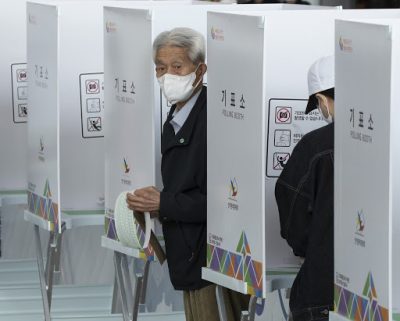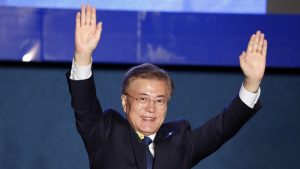The Parliamentary Election in South Korea. Moon Jae-in Phenomenal Victory
Victory of the Democratic Party over the Alliance between the Conservative Party and the COVID-19

The Democratic Party of President Moon Jae-in won a phenomenal victory at the parliamentary election on April 15.
This victory has been widely reported in media throughout the world with flattery terms. Most of the media seem to attribute this victory to the remarkable success of Moon Jae-in government’s handling of the corona virus crisis.
I join the international media in praising Moon’s victory. But I am asking three questions in order to better see the meaning of the victory.
How was it possible to hold an open general election in a situation where the COVID-19 is still threatening? What are the fundamental determinants of the election outcome? What are the impact of the victory of the Democratic Party on internal policies and North-South relations?
The Election Process and Results
The April election was astonishing not only for its planning and management of organization but also for its outcome.
Three factors seem to explain the surprising success of the election planning an organization.
First, the Election Commission and the media were successful in convincing the people to come out vote so that they can tell the government what they want.
Second, a well planned programme of the election process and the people’s respect for the government instruction was an important factor.
Third, the brilliant performance of the Korea Center for Disease Control and Prevention (KCDC) has inspired to the people to vote.
The rate of votes was as high as 66.2%. Of 44 million eligible voters, 30 million came out and voted. It was the highest rate of votes since 1992.
This is just amazing. In the world, more than 47 countries have postponed or cancelled the election because of the COVID-19. Korea is the only country that has dared holding a large-scale election with success, despite the threat of the corona virus.
The well planned and well managed process of voting was a factor of the success.
It began with the sanitization of election booths. The voter had to wear mask and put on plastic gloves. They were obliged to line up with 3 meter distance.
At the entrance to the voting booth, voters’ temperature is measured. If it is above 37.5 C, the voter was taken to separate voting booths. The voters obeyed these instructions and rules
The Korean parliament system is the unicameral system. There are 300 seats.
Before the election, of 300 seats, 270 were elected by single seat constituencies, while 30 seats were proportional representation seats.
Now, after the election of April 15 this year, the proportional seats increased from 30 to 47 seats. The idea was to better represent the people’s wish that is not properly reflected by the seats elected at electoral constituencies.
The National Assembly (NA) is, by and large, represented by two loosely defined political ideologies: the right-wing (conservatives) and the left-wing (welfare state regime).
The April election was for the 21st NA, which will begin to operate on May 31st. Until then, the 20th NA will operate.
The comparison of the composition of the two NAs will show the surprising results of the April 15 election.
In the 20th NA, the left-wing was represented by the Democratic Party (DP) with 123 seats and the Justice Party (mild socialism) with 6 seats. Thus, the left-wing had 129 seats accounting for 43%of the total number of seats in the NA.
On the other hand, the right-wing included the Liberty Korea Party (LKP) with 122 seats and the People’s Party with 38 seats giving a total of 160 seats, accounting for 53.3%.The independents had 11 seats, that is, 3.7%.
Thus, in the 20th NA, the left-wing had 43% of the total number of seats as against 53.3 % for the conservative party.
The DP representing the left-wing was the “first party” in terms of the number of seats and it was the ruling party. But, having less than 50% of the total number of seats in the NA, the DP had to rely on the conservative party (LKP) to pass laws.
The April election has changed drastically the seat composition of the NA.
The left-wing represented by the DP with 163 seats, Citizen Party with 17 seats, the Justice Party with 6 seats and Open Democratic Party with 3 seats assured as many as of 189 seats, that is, 63% of the total number of seats.
Now, the right-wing composed of the United Future Party (UFP) (new name of the LKP) with 84 seats, Future Korea Party with 19 seats and People Party with 3 obtained only 106 seats representing 35.3%
There are 5 independents representing 1.7%. These independents are former member of the LKP. This means that the right-wing seats in the 21st NA are 111, that is, 37%.
Thus, the number of the left-wing seats increased from 129 seats (42%) to 189 seats (63%), while that of the right-wing seats fell from 160 (58%) to 111 (37%).
Determinants of the Left-Wing Victory led by the Democratic Party
The amazing outcome of the April election is attributable to the way each party has deal with the threat of the COVID-19, on the one hand, and, on the other, the performance of each party at the 20th National Assembly.
The government of Moon Jae-in has shown outstanding performance in handling the corona virus crisis.
As I have shown in my previous Global Research paper (1) the government has been handling well the crisis owing to the apolitical approach, its reliance on science and technology, remarkable Moon’s leadership and the people’s participation in the fight and cooperation with the government.
In contrast, the conservative party the UFP has been telling the voters that the government’s fight against the virus was a failure.
The voters knew that the Korean model of COVID-19 war became the object of global praise and many countries were soliciting Korea’s help including the U.S. The voters did not like the conservatives which criticize the government for the sake of criticizing.
There was another reason for not liking the conservatives. The swift propagation of the corona virus was started and sustained by the members of the cult sect, the Shincheonji.
The conservative party gave the clear impression that it supported the cult’s criminal behaviour of propagating the virus.
In this way, the Democratic Party had to fight against an alliance between the conservative party and the COVID-19.
The conservatives made another mistake. Since the establishments Moon’s government in 2017, the right-wing political parties led by the LKP (now UFP) did every possible trick to paralyze the function of the NA.
In a situation where 60% of Koreans approve Moon’s policies, such behaviour of the UFP was a suicidal approach.
The combination of all these damaging factors has led to the humiliating defeat of the conservative party.
Challenge of the Victorious Democratic Party
The Democratic Party has won a crushing victory. With more than 180 seats, it can pass laws without the votes of the opposition party.
But, it must be aware of one thing. The conservatives have lost the seats, but, still, in terms of votes, they represent about 40% of the total number of votes in the NA. It means that, if the Moon’s government does not meet the people’s expectation, it may lose at the next presidential election in 2022.
What are the people’s expectations?
It appears that we can group people’s expectations into four groups: final victory of the anti-virus war, the recovery of the economy, the definitive destruction of the corruption culture and the North-South economic cooperation.
The fight against the corona virus is not over yet. It is true that the number of newly infected is single-digit figure but some of the “cured” are re-infected; the risk of imported infected is still there.
Korea is relaxing the confinement starting with restaurants, parks and some other places. Korea was contemplating also the opening of schools, but the recent experience of Singapore seems to delay such decision. In Singapore, as soon as the schools were open, the number of the infected skyrocketed.
If the victory over the corona virus fight had the first priority after the election win, the next priority is the recovery of the economy.
We must remember that even without the invasion of the virus, Korean economy was in deep trouble largely because of decades-long neoliberal pro-Chaebol and export-led economic growth policies.
The results of these policies were the shrinking growth rate of GDP because of Chaebols’ losing international competitiveness on the one hand and, on the other, worsening income distribution and shrinking domestic demand.
Moon’s government has undertaken a series of measure to balance the lopsided income distribution along with the vitalization of small-and medium-sized enterprises (SMEs) to assure more sustainable economic growth. This policy will be accelerated. But at the same time, the government has to inject a huge amount of money into the economy to rescues SMEs hard hit by the corona virus crisis.
The social reform and the purification of 7-decades old corruption culture of the conservatives will have to go on. The first step is to reform the Bureau of Prosecutors and the police. Then, in the long run, the government should confiscate the wealth hidden by the conservatives in various forms of assets throughout the world.
Then, there is the difficult task of assuring greater autonomy in dealing with the North-South relations.
It appears that North Korea is hit hard by the COVID-19, but it has no physical or financial capacity to cope with, largely because of decades of U.S.-led sanctions.
It is the time to improve the North-South relations hoping that it will lead to the reopening of the Gaesung Industrial Complex and the Kumgang-san Tourist Center.
These two facilities are under sanctions imposed unilaterally by the conservative government of Lee Myong-bak who is judged guilty of corruption and abuse of power; he has been sentenced for 17-year imprisonment.
It is true that the Democratic Party has gained almost two-third of the sears in the National Assembly. It is true also that it will be easier to pass laws.
But the people’s expectation is proportional to the number of seats. The people of Korea has given to the government the tall order to eliminate the corona virus, make the economy grow, generate jobs, free Korea from the corruption culture and hold hands with North Korea for peace on the peninsula and co-prosperity for all Koreans. Good luck!
*
Note to readers: please click the share buttons above or below. Forward this article to your email lists. Crosspost on your blog site, internet forums. etc.
Professor Joseph H. Chung is professor of economics and co-director of the Observatoire de l’Asie de l’Est (OAE) – the Centre d’Études de l’intégration et la Mondialisation (CEIM), Université du Québec à Montréal (UQAM). He is a Research Associate of the Centre for Research on Globalization (CRG).
Note
(1) Joseph H. Chung (March 31, 2020). globalresearch.ca/korean-model-anti-covid-19-war-how-successful-why-successful/5708164
Featured image is from Xinhua


